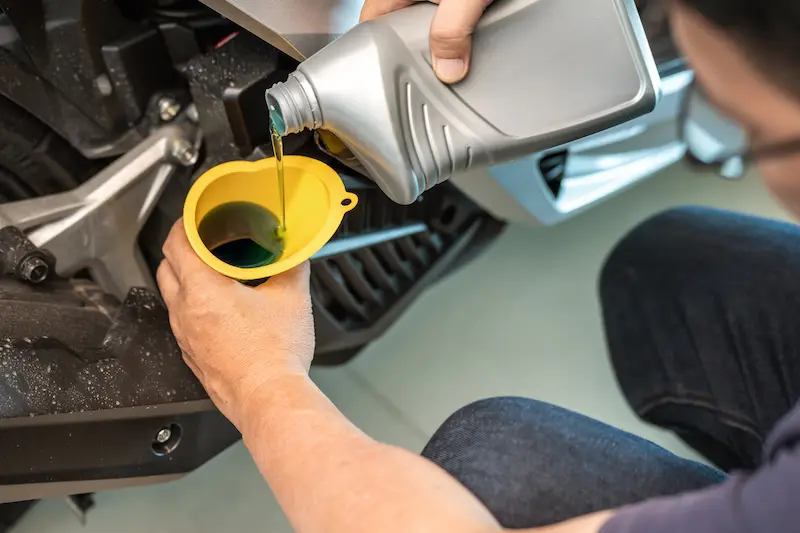Knowing how to check your transmission fluid can save you time, money, and potential headaches down the road. Transmission fluid keeps your vehicle’s gears shifting smoothly, so ensuring it’s at the right level and in good condition is vital. Whether you’re tackling maintenance on your own or preparing for a professional check-up, understanding this process gives you more control over your car’s performance.
In this guide, we’ll cover everything you need to inspect your transmission fluid like a pro. From gathering the right tools to reading the dipstick accurately, you’ll learn simple steps to keep your transmission in top shape. Plus, we’ll explain when it’s time to schedule professional maintenance, ensuring your car stays reliable for the long haul.
Tools You’ll Need for a Proper Inspection
Checking your transmission fluid doesn’t require a mechanic’s toolbox, but having the right tools makes the process smoother and more effective. With just a few essential items, you’ll be ready to inspect fluid levels and ensure your transmission is in top shape.
A Clean, Lint-Free Rag or Paper Towel
Your first must-have tool is simple: a clean, lint-free rag or paper towel. You’ll use this to wipe the dipstick clean before checking the fluid. A clean rag ensures you get an accurate reading without dust or debris interfering. Paper towels work well too, but make sure they don’t leave fibers behind on the dipstick.
This small item is often overlooked, but it’s essential for spotting any discoloration or debris in the transmission fluid.
A Funnel for Easy Refilling
If you need to top off your transmission fluid, a funnel will make the process mess-free. Transmission fluid can be tricky to pour, and spilling it around the engine can cause a mess. Using a funnel ensures the fluid goes exactly where it’s needed without waste.
Keep a dedicated funnel just for this purpose. Mixing oil or other fluids with your funnel could contaminate the transmission, so it’s best to have one specifically for transmission fluid.
The Correct Transmission Fluid
Not all transmission fluids are the same, so knowing the correct type for your car is crucial. Check your owner’s manual or consult your mechanic to ensure you’re using the recommended fluid. Using the wrong type could lead to issues with your transmission’s performance.
Having a container of the right transmission fluid on hand lets you top off levels or replace old fluid when necessary.
Gloves for a Cleaner Job
While gloves aren’t mandatory, they’re a good idea if you want to keep your hands clean. Transmission fluid can be slick and hard to wash off, so a pair of disposable or reusable gloves adds convenience. They’re especially helpful if your engine is warm or if you’re checking fluid on a hot day.
Gloves also provide extra grip, making it easier to handle the dipstick without fumbling.
A Flashlight for Better Visibility
If you’re inspecting your transmission fluid in a dimly lit area or at night, a flashlight can be a lifesaver. Use it to get a clear view of the dipstick, the fluid’s color, and the fill tube. This tool is especially useful if you’re working on a larger vehicle where components might be harder to see.
A Flat, Level Surface
This might not sound like a tool, but parking your car on a flat, level surface is essential for an accurate transmission fluid reading. Uneven ground can tilt the fluid levels, making it difficult to get a proper measurement. If you’re at home, your driveway or garage floor is perfect for this task.
Step-by-Step Guide to Checking Transmission Fluid Levels
Checking your transmission fluid might sound like a chore, but it’s easier than you think. With a clear step-by-step guide, you’ll feel like a pro in no time. Let’s walk through the process to ensure your car stays in great shape.
Step 1: Warm Up Your Engine
Start by turning on your car and letting the engine run for about 5 to 10 minutes. This warms up the transmission fluid and ensures an accurate reading. Be sure to park the car on a flat, level surface and set the parking brake for safety.
Warming up the engine helps the transmission fluid flow through the system, giving you a clear picture of the levels.
Step 2: Locate the Dipstick
Pop the hood and look for the transmission dipstick. In most cars, it’s near the back of the engine bay, separate from the oil dipstick. If you’re not sure where it is, your owner’s manual will point you in the right direction.
Once you’ve found the dipstick, wipe it clean with a lint-free rag. This ensures any old residue won’t affect your reading.
Step 3: Insert and Remove the Dipstick
Insert the dipstick back into the tube and push it all the way down. Then, pull it out carefully. Look at the end of the dipstick to see where the fluid level reaches.
This step is key for understanding whether your transmission fluid is within the safe range. Most dipsticks have markers like “Full” and “Add” to guide you.
Step 4: Check the Fluid’s Color and Consistency
While you have the dipstick out, take a closer look at the fluid’s color and texture. Healthy transmission fluid is usually pinkish-red and should be clear. If it’s dark, brown, or smells burnt, it might be time for a replacement.
Rub a little fluid between your fingers to check for grit or debris. Clean, smooth fluid indicates your transmission is in good shape.
Step 5: Add Fluid if Necessary
If the fluid level is below the “Full” mark, use a funnel to add the correct type of transmission fluid for your car. Add small amounts at a time, rechecking the level with the dipstick to avoid overfilling.
Using the right fluid is crucial, so double-check your owner’s manual to ensure you’re adding the correct type for your vehicle.
Step 6: Reinsert the Dipstick and Close the Hood
Once you’ve finished checking and adjusting the fluid, reinsert the dipstick securely. Make sure the cap is on tight if your dipstick has one. Finally, close the hood and give yourself a pat on the back—you’ve just checked your transmission fluid like a pro!
Understanding the Dipstick Reading
Checking your transmission fluid is only half the battle; understanding what the dipstick reading tells you is where the magic happens. A quick glance at the dipstick can reveal your fluid level, condition, and whether it’s time to top up or call in a pro. Here’s how to interpret the dipstick like a seasoned car enthusiast.
Decoding the Fluid Level Markings
The dipstick usually has two key markers: “Full” and “Add” (sometimes labeled “Cold” and “Hot” for temperature ranges). If your transmission fluid level is between these markers, you’re in the safe zone. If it’s below the “Add” mark, it’s time to add a little fluid.
Always make sure your car is on level ground for an accurate reading. If your fluid seems inconsistent—high one time, low another—you might have a leak. Catching this early can save you from bigger transmission issues later.
Checking the Fluid’s Color and Smell
Transmission fluid tells a story about your car’s health, and the color is a key chapter. Healthy transmission fluid is pink or red and has a clear consistency. If it’s brown, dark, or has a burnt smell, it’s likely overdue for a change.
Rub a bit of fluid between your fingers—it should feel smooth, not gritty. Grit or debris indicates potential transmission wear, so schedule maintenance if you notice these signs. A quick visual and tactile check keeps you ahead of potential problems.
Identifying Temperature Differences
Transmission fluid expands as it warms, so the reading can vary depending on whether your car is warm or cold. Some dipsticks are labeled with both “Hot” and “Cold” levels, while others require you to warm the engine before checking. Always follow your owner’s manual for the best practice.
If your car has been running for a while, ensure the engine is warm, but not excessively hot, to avoid burns. Checking at the right temperature ensures you get the most accurate reading.
When to Schedule Professional Maintenance
Regularly checking your transmission fluid is a great habit, but some situations call for professional help. Transmission maintenance goes beyond what you can do at home, ensuring your car stays reliable and your transmission lasts longer. Knowing when to schedule a visit to your mechanic can save you from costly repairs and keep your car running smoothly.
Let’s break down when it’s time to bring in the pros and why professional maintenance is a crucial part of caring for your transmission.
Recognizing the Signs That It’s Time for Maintenance
Some warning signs indicate your transmission might need professional attention. If your transmission fluid appears dark, gritty, or has a burnt smell, it’s time to schedule maintenance. These signs suggest that the fluid has degraded and is no longer lubricating and cooling the transmission effectively.
Other symptoms, like slipping gears, delayed shifting, or unusual noises when changing gears, are major red flags. These issues can indicate internal transmission problems that require a trained mechanic to diagnose and repair. Ignoring these signs could lead to expensive repairs—or worse, complete transmission failure.
Even if your car seems to drive fine, small changes like reduced fuel efficiency or difficulty accelerating might be linked to transmission fluid issues. It’s always better to address these problems early with professional help.
Following the Recommended Maintenance Schedule
Your car’s manufacturer provides a maintenance schedule for a reason. This schedule includes recommendations for when to check and replace your transmission fluid. For most vehicles, fluid replacement is suggested every 30,000 to 60,000 miles, though this can vary. Check your owner’s manual for specific guidance tailored to your car.
If you drive in challenging conditions, like stop-and-go traffic, towing heavy loads, or on steep inclines, you may need more frequent maintenance. These conditions put extra stress on your transmission, causing the fluid to degrade faster. Regular professional checks ensure your car handles these demands without issue.
Even if you’re diligent about checking your transmission fluid at home, following a professional maintenance schedule ensures every component of your transmission system is inspected. A mechanic can identify potential issues before they escalate, saving you time, money, and stress.
Why Professional Maintenance Matters
While DIY checks are great for spotting early signs of trouble, professional maintenance offers a deeper level of care. Mechanics use advanced diagnostic tools to check your transmission’s overall health. They can detect leaks, assess wear and tear on internal components, and ensure the entire system functions correctly.
A professional transmission service typically includes flushing out old fluid, which removes contaminants that can’t be eliminated through simple draining. The mechanic then refills the system with the correct type of fluid for your car. Using the right fluid is crucial—each transmission type has specific requirements, and the wrong fluid can cause significant damage.
Professional services also often include adjustments to your transmission’s settings or software (if applicable), ensuring your car operates at peak efficiency. These small tweaks can make a big difference in performance and longevity.
Balancing DIY Checks and Professional Maintenance
DIY checks are a fantastic way to stay on top of your car’s health, but they’re not a substitute for professional care. Your mechanic has the expertise and tools to handle complex transmission issues and perform tasks you can’t do at home.
By combining routine checks with regular professional maintenance, you’ll keep your car’s transmission in excellent shape. This approach helps catch small problems before they turn into expensive repairs, ensuring your car runs reliably for years to come.
Keeping Your Transmission Fluid in Check
Checking your transmission fluid doesn’t have to be intimidating. With the right tools, a clear step-by-step guide, and a little patience, you can stay on top of your car’s maintenance like a pro. Routine checks ensure your fluid is at the proper level, in good condition, and ready to keep your transmission running smoothly. It’s a small effort that makes a big difference in your car’s performance.
Understanding the dipstick reading is just as important as checking the fluid. Knowing how to interpret the color, texture, and level helps you spot potential issues early. When in doubt, don’t hesitate to schedule professional maintenance. Experts can address more complex problems, flush old fluid, and keep your transmission in peak condition.
By combining DIY checks with professional care, you’ll extend your transmission’s lifespan and save on costly repairs. Staying proactive with your transmission fluid maintenance ensures a safer, more reliable driving experience. Whether you’re a seasoned car enthusiast or a beginner, these tips make caring for your transmission simple and stress-free.







